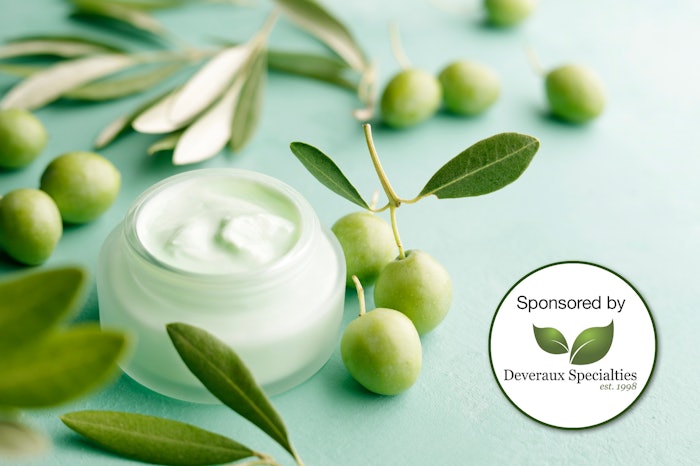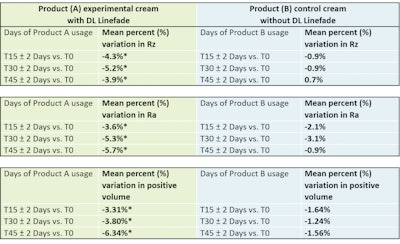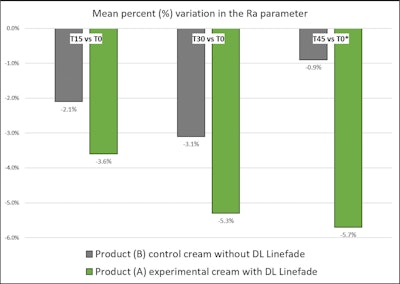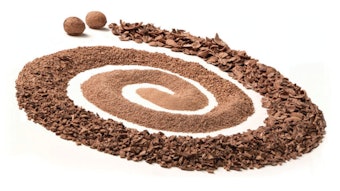
Not all collagen-promoting ingredients are the same

This protein resides closer to the skin’s surface, located at the interface of the epidermis and dermis. The structural features of collagen IV include a unique pliable consistency, which is organized in a sheet-like network forming an anchor between the skin layers1. With chronological aging, collagen IV progressively depletes, and the dermal-epidermal junction (DEJ) flattens leading to a loss of the skin’s youthful structural properties2. These changes that occur at the DEJ contribute to the age-related remodeling of the skin, and produce visible signs of aging.
DL Linefade, a novel collagen IV promoter
Olive leaf, rich in a variety of antioxidants and bio-active compounds, is known to contain several lipid-soluble molecules which exhibit PPAR-activation. Peroxisome proliferator-activated receptors (PPAR) are known to play an important role in maintaining epidermal homeostasis and regulating the synthesis of lipids and proteins3.
 Figure 1. Stimulatory effect of DL Linefade on the synthesis of collagen type IV expressed as percentage of water control. Data are presented as mean values ± SEM, n = 6; **p-value < 0.01 vs. water blank
Figure 1. Stimulatory effect of DL Linefade on the synthesis of collagen type IV expressed as percentage of water control. Data are presented as mean values ± SEM, n = 6; **p-value < 0.01 vs. water blank
In early research, we have discovered that DL Linefade prepared from olive leaf activates PPAR-α transcriptional regulation and induces collagen IV synthesis in both cultured cells and human skin explant models4. In a human fibroblast cell-culture model, DL Linefade increased collagen IV output by 219% as shown in Figure 1. Further, a human skin explants model (Figure 2) confirmed that collagen IV (stained in green) along the epidermal-dermal junction had increased with the application of just 1% DL Linefade in a triglycerides carrier.
 Figure 2. Effects of DL Linefade on collagen IV synthesis in human skin explants vs. untreated and excipient-treated controls after 3 Days of incubation. Collagen IV was detected by immunostaining using specific antibodies. Number of explants per condition = 3. Yellow arrows locate the dermal-epidermal junction.
Figure 2. Effects of DL Linefade on collagen IV synthesis in human skin explants vs. untreated and excipient-treated controls after 3 Days of incubation. Collagen IV was detected by immunostaining using specific antibodies. Number of explants per condition = 3. Yellow arrows locate the dermal-epidermal junction.
A 45-Day split-face image analysis study comparing [DL Linefade + Niacinamide] vs. [Niacinamide]
With such compelling in vitro/ex vivo findings, two skin creams were prepared with and without DL Linefade to examine the possible clinical skin care benefits. Niacinamide, a commonly utilized skin conditioning ingredient for photo-aged skin, was added as a positive control into both the experimental (Product A) and control (Product B) creams.
To quantify changes in human skin, a 45-day split face image analysis study was conducted by comparing Products A and B. This single-blinded randomized study was carried out on 20 healthy female volunteers, at the average age of (N=20) 43 years old. The study was conducted to evaluate the efficacy of Products A and B for (1) improving crow’s feet roughness and wrinkles, and for (2) reducing facial sagging. The assessment techniques utilized a positioning bench instrument for 3D facial measurement and VisioTOP-300® with AEVA-V3 image analysis software system (EOTECH, France). Image topography analysis intends to study quantitatively the skin roughness with scientifically validated methodologies, largely used in controlled clinical trials. Based on these considerations, crow’s feet evaluation implied the following analyses and monitoring of the following parameters:
- Mean depth of roughness (Rz) represents the arithmetic average of the different segment roughness calculated from 5 succeeding measurement segments of the same length. This parameter can be associated with changes in wrinkles.
- Arithmetical mean of roughness (Ra) is the generally used parameter for the evaluation of skin roughness since it is based on the sampling of all the points characterizing the micro profile of the skin. This parameter can be associated with changes in roughness and fine lines.
- The variation of positive volume is simply that which protrudes above from the reference plane. The reference plane baseline was calculated at T0. Topographical analysis was made to evaluate changes in volume around the jaw contour zone. This parameter can be associated with changes in facial sagging.
Image analysis results in crow’s feet roughness, wrinkles and facial sagging
Intra-group analysis
Usage of Product A (with DL Linefade) induced significant intra-group improvements at Day 15, Day 30, Day 45 vs. Day 0 (baselines) in all parameters: Rz, Ra and positive volume. Usage of Product B (without DL Linefade) did not yield significant intra-group changes at Day 15, Day 30, Day 45 vs. Day 0 (baselines) in all parameters: Rz, Ra and positive volume as shown in Figure 3.
 Figure 3. Intra-group image analysis. Percent change with respect to Day 0 of mean Rz, mean Ra and mean variation of positive volume at different time points (Day 15, Day 30, Day 45) of product usage in a split face application with N=20 subjects. *p values refer to a statistically significant variation value when below 0.05.
Figure 3. Intra-group image analysis. Percent change with respect to Day 0 of mean Rz, mean Ra and mean variation of positive volume at different time points (Day 15, Day 30, Day 45) of product usage in a split face application with N=20 subjects. *p values refer to a statistically significant variation value when below 0.05.
Inter-group analysis
The split-face study findings shown in Figures 4, 5, and 6 are published in the Journal of Cosmetic Dermatology, a peer-reviewed journal which explores imaging techniques in dermatology, cosmetology and plastic surgery5.
 Figure 4 compares the experimental and control products in a split-face inter-group analysis. Product A demonstrates a significant reduction at Day 15, Day 30, Day 45 time points as compared to Product B in the Rz parameter. *p values refer to a statistically significant variation value when below 0.05.
Figure 4 compares the experimental and control products in a split-face inter-group analysis. Product A demonstrates a significant reduction at Day 15, Day 30, Day 45 time points as compared to Product B in the Rz parameter. *p values refer to a statistically significant variation value when below 0.05. Figure 5. Product A demonstrates a significant reduction at Day 45 as compared to Product B in the Ra parameter. *p values refer to a statistically significant variation value when below 0.05.
Figure 5. Product A demonstrates a significant reduction at Day 45 as compared to Product B in the Ra parameter. *p values refer to a statistically significant variation value when below 0.05. Figure 4 compares the experimental and control products in a split-face inter-group analysis. Product A demonstrates a significant reduction at Day 15, Day 30, Day 45 time points as compared to Product B in the Rz parameter. *p values refer to a statistically significant variation value when below 0.05.
Figure 4 compares the experimental and control products in a split-face inter-group analysis. Product A demonstrates a significant reduction at Day 15, Day 30, Day 45 time points as compared to Product B in the Rz parameter. *p values refer to a statistically significant variation value when below 0.05.
DL Linefade, a new ingredient for anti-aging skin care
Existing collagen-promoting ingredients support dermal collagens I and III, yet effective delivery of these ingredients into the deeper layers of the dermis are not well understood and prone to regulatory challenges. In contrast, DL Linefade targets the collagen-connectivity between skin layers located near the skin’s surface.
In vitro, ex vivo and in vivo findings demonstrate how this approach translates into significant improvements in skin roughness, wrinkles, and facial sagging. DL Linefade prepared from plant-derived compounds is lipid-soluble, easy to formulate and has been shown to improve the performance of niacinamide containing creams. DL Linefade is ideal for inclusion into functional skin care products offering formulators a new option for creating result-driven skin care.
References:
- Abreu-Velez AM, Howard MS. Collagen IV in Normal Skin and in Pathological Processes. N Am J Med Sci. 2012 Jan;4(1):1-8. doi: 10.4103/1947-2714.92892. PMID: 22393540; PMCID: PMC3289483.
- Langton AK, Halai P, Griffiths CE, Sherratt MJ, Watson RE. The impact of intrinsic ageing on the protein composition of the dermal-epidermal junction. Mech Ageing Dev. 2016 Jun;156:14-6. doi: 10.1016/j.mad.2016.03.006. Epub 2016 Mar 21. PMID: 27013376.
- Majewski G, Craw J, Falla T. Accelerated Barrier Repair in Human Skin Explants Induced with a Plant-Derived PPAR-α Activating Complex via Cooperative Interactions. Clin Cosmet Investig Dermatol. 2021 Sep 18;14:1271-1293. doi: 10.2147/CCID.S325967. PMID: 34566418; PMCID: PMC8458040.
- Majewski GP, Singh S, Bojanowski K. Olive leaf-derived PPAR agonist complex induces collagen IV synthesis in human skin models. Int J Cosmet Sci. 2021 Dec;43(6):662-676. https://doi.org/10.1111/ics.12742. Epub 2021 Nov 4. PMID: 34661292.
- Majewski, G.P., Marchesi, P. and Bojanowski, K. (2022), Niacinamide + “Linefade” ameliorate crow’s feet wrinkles and facial sagging in a split-face image analysis study. J Cosmet Dermatol. https://doi.org/10.1111/jocd.15459.
Disclaimer:
The above paid-for content was produced by and posted on behalf of the Sponsor. Content provided is generated solely by the Sponsor or its affiliates, and it is the Sponsor’s responsibility for the accuracy, completeness and validity of all information included. Global Cosmetic Industry takes steps to ensure that you will not confuse sponsored content with content produced by Global Cosmetic Industry and governed by its editorial policy.










